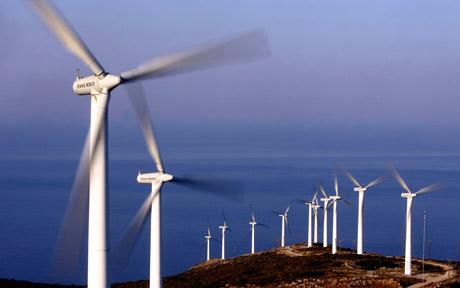An ill wind is blowing over Italy’s green revolution, as the Mafia seek to capitalise on generous grants for renewable energy.

Photo: AFP/GETTY IMAGES
They rise up high above the sun-scorched countryside, looking out over hilltop villages, palm trees, neatly-tended vineyards and olive groves.
But for all their promises of a clean, green future, Italy’s windfarms have now acquired a somewhat dirtier whiff – as the latest industry to be infiltrated by the country’s mobsters.
Attracted by the prospect of generous grants designed to boost the use of alternative energies, the so-called “eco Mafia” has begun fraudulently creaming off millions of euros from both the Italian government and the European Union.
And nowhere has the industry’s reputation become more tarnished than Sicily, where windmills now dot the horizon in Mafia strongholds like Corleone, the town better known as the setting for the Godfather films.
“Nothing earns more than a wind farm,” said Edoardo Zanchini, an environmental campaigner who has investigated Mafia infiltration of the industry. “Anything that creates wealth interests the Mafia.”
It is not just Italian criminals, however, who have spotted the potential for corruption. Recent research by Kroll, the international corporate security firm, has discovered examples all over Europe of so-called “clean energy” schemes being used to to line criminals’ pockets rather than save the planet. Some involve windmills that stand derelict or are simply never built, while others are used to launder profits from other crime enterprises.
“Renewable energy seems like a good thing, run by saintly people saving the world,” said Jason Wright, a senior director with Kroll, which performs background checks on renewable energy schemes on behalf of legitimate investors, and which has documented a sharp rise in the number of wind farms with suspect ownership.
“But a lot of people want to jump on board a sure-fire revenue spinner. I wouldn’t say the entire sector is corrupt, but there is a small percentage of corrupt projects.”
The level of fraud has prompted calls for tighter restrictions on the use of public money in funding renewable energy, for which EU bureaucrats have grand ambitions. Brussels has ordered all 27 EU nations to ensure that one-fifth of their energy is renewable by 2020, and in recent years has given out an average of €5 billion (£4.1 billion) annually in loans and grants. The levels of subsidy allow some wind farm owners to claim generous premiums for every watt of electricity they generate.
In Italy, for example, power from wind farms is sold at a guaranteed rate of €180 per kwh – the highest rate in the world. In a country where the Mafia has years of expertise at buying corrupt politicians and intimidating rivals, the result is perhaps inevitable, creating a new breed of entrepreneur known as the “lords of the wind”.
Read moreMafia Cash In On Lucrative EU Wind Farm Handouts – Especially In Sicily


